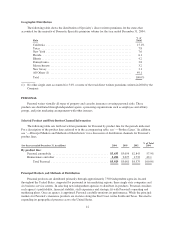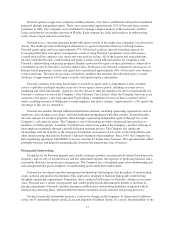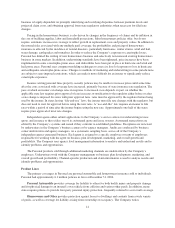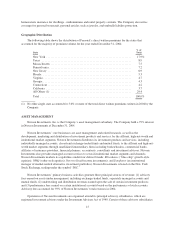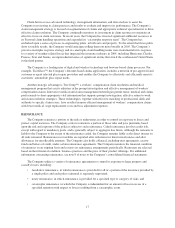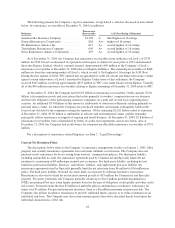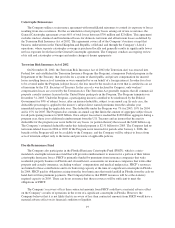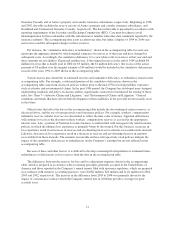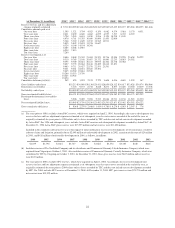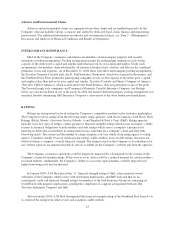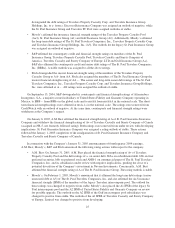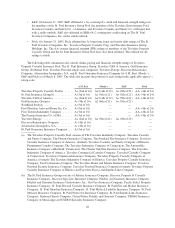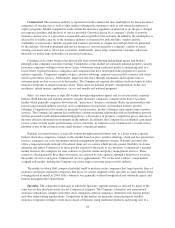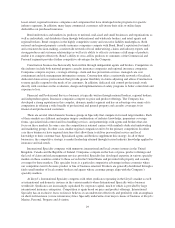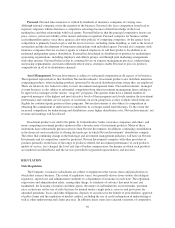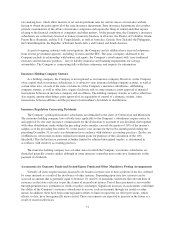Travelers 2004 Annual Report Download - page 33
Download and view the complete annual report
Please find page 33 of the 2004 Travelers annual report below. You can navigate through the pages in the report by either clicking on the pages listed below, or by using the keyword search tool below to find specific information within the annual report.Guaranty Casualty and of Aetna’s property and casualty insurance subsidiaries, respectively. Beginning in 1996
and 2002, the table includes the reserve activity of Aetna’s property and casualty insurance subsidiaries, and
Northland and Commercial Guaranty Casualty, respectively. The data in the table is presented in accordance with
reporting requirements of the Securities and Exchange Commission (SEC). Care must be taken to avoid
misinterpretation by those unfamiliar with this information or familiar with other data commonly reported by the
insurance industry. The accompanying data is not accident year data, but rather a display of 1994 to 2004 year-
end reserves and the subsequent changes in those reserves.
For instance, the “cumulative deficiency or redundancy” shown in the accompanying table for each year
represents the aggregate amount by which original estimates of reserves as of that year end have changed in
subsequent years. Accordingly, the cumulative deficiency for a year relates only to reserves at that year-end and
those amounts are not additive. Expressed another way, if the original reserves at the end of 1994 included $4
million for a loss that is finally paid in 2004 for $5 million, the $1 million deficiency (the excess of the actual
payment of $5 million over the original estimate of $4 million) would be included in the cumulative deficiencies
in each of the years 1994 to 2003 shown in the accompanying table.
Various factors may distort the re-estimated reserves and cumulative deficiency or redundancy shown in the
accompanying table. For example, a substantial portion of the cumulative deficiencies shown in the
accompanying table arise from claims on policies written prior to the mid-1970s involving liability exposures
such as asbestos and environmental claims. In the post-1984 period, the Company has developed more stringent
underwriting standards and policy exclusions and has significantly contracted or terminated the writing of these
risks. See “Item 7—Asbestos Claims and Litigation,” and “Environmental Claims and Litigation.” General
conditions and trends that have affected the development of these liabilities in the past will not necessarily recur
in the future.
Other factors that affect the data in the accompanying table include the discounting of certain reserves, as
discussed above, and the use of retrospectively rated insurance policies. For example, workers’ compensation
indemnity reserves (tabular reserves) are discounted to reflect the time value of money. Apparent deficiencies
will continue to occur as the discount on these workers’ compensation reserves is accreted at the appropriate
interest rates. Also, a portion of National Accounts business is underwritten with retrospectively rated insurance
policies in which the ultimate loss experience is primarily borne by the insured. For this business, increases in
loss experience result in an increase in reserves and an offsetting increase in amounts recoverable from insureds.
Likewise, decreases in loss experience result in a decrease in reserves and an offsetting decrease in amounts
recoverable from these insureds. The amounts recoverable on these retrospectively rated policies mitigate the
impact of the cumulative deficiencies or redundancies on the Company’s earnings but are not reflected in the
accompanying table.
Because of these and other factors, it is difficult to develop a meaningful extrapolation of estimated future
redundancies or deficiencies in loss reserves from the data in the accompanying table.
The differences between the reserves for loss and loss adjustment expenses shown in the accompanying
table, which is prepared in accordance with accounting principles generally accepted in the United States of
America and those reported in the Company’s annual reports filed with insurance regulators, which are prepared
in accordance with statutory accounting practices, were $(282) million, $26 million and $(12) million for 2004,
2003 and 2002, respectively. The increase in the difference from 2003 to 2004 was primarily driven by the
impact of a reinsurance contract which the Company entered into in 2004 that provides coverage for prior
accident years.
21



